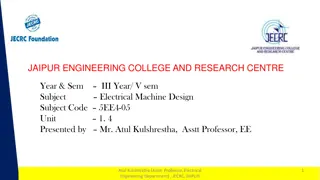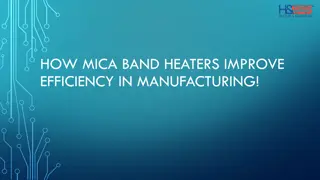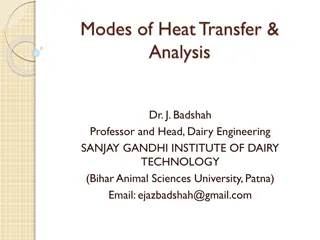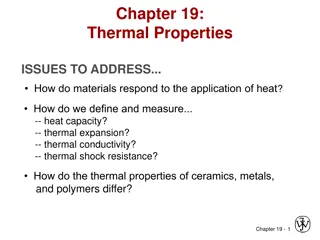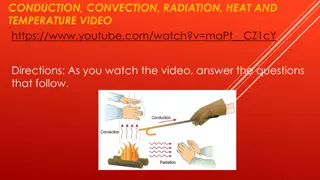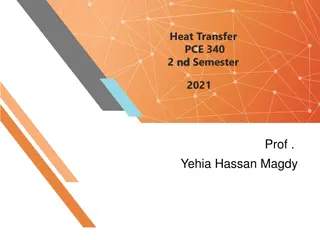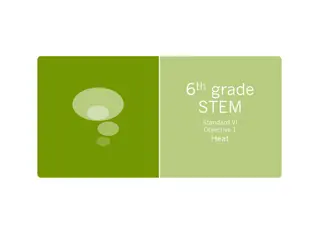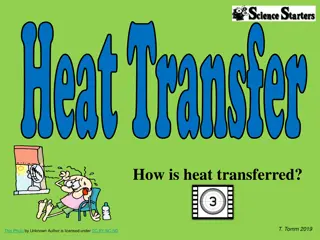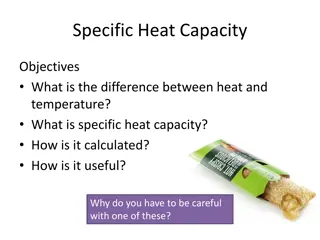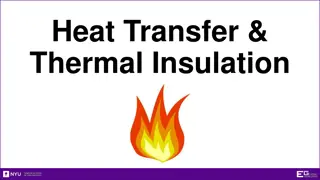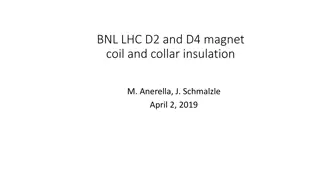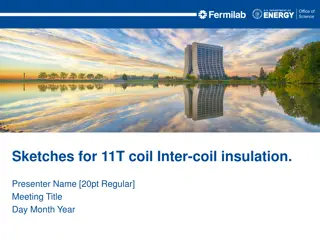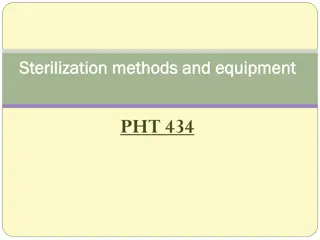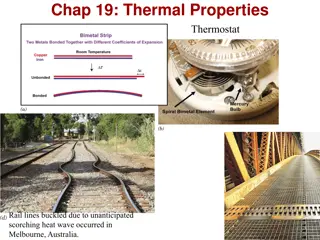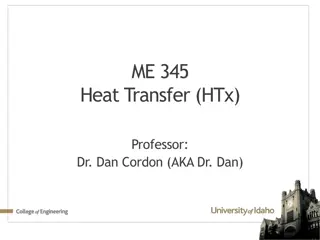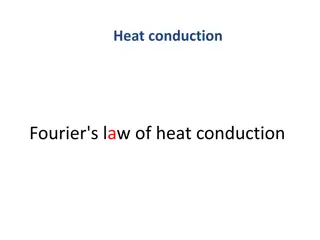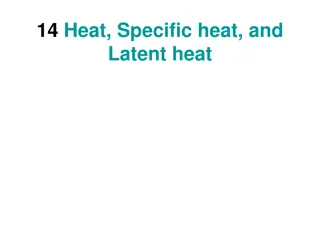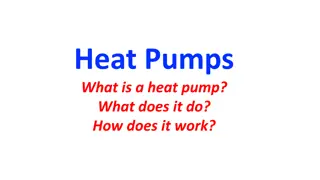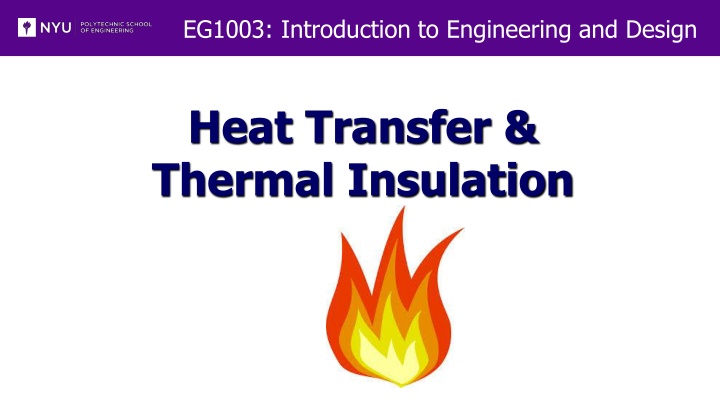
Heat Transfer & Thermal Insulation Overview
In this course on heat transfer and thermal insulation, students will design and construct a container to minimize heat loss from an egg. Topics covered include thermodynamic systems, temperature, heat transfer mechanisms, equilibrium, and means of heat transfer such as conduction, convection, and radiation.
Uploaded on | 0 Views
Download Presentation

Please find below an Image/Link to download the presentation.
The content on the website is provided AS IS for your information and personal use only. It may not be sold, licensed, or shared on other websites without obtaining consent from the author. If you encounter any issues during the download, it is possible that the publisher has removed the file from their server.
You are allowed to download the files provided on this website for personal or commercial use, subject to the condition that they are used lawfully. All files are the property of their respective owners.
The content on the website is provided AS IS for your information and personal use only. It may not be sold, licensed, or shared on other websites without obtaining consent from the author.
E N D
Presentation Transcript
EG1003: Introduction to Engineering and Design Heat Transfer & Thermal Insulation https://encrypted-tbn1.gstatic.com/images?q=tbn:ANd9GcT_7A9lmyFjhCWijtZTPkiEtmXDJdkeNLAoKsDqL_1WVKVAMj1N2A
Overview Objective Background Materials Procedure Report / Presentation Closing
Objectives Design and construct container to minimize heat loss from an egg within Understand concept of minimal design Understand: Thermodynamic systems Temperature Heat and heat transfer
Thermodynamic Systems Part of the universe separated from the surroundings by a boundary (real or imaginary) 3 types of systems: Open system: exchange energy and matter Closed system: exchange energy Isolated system: no exchange
Temperature Qualitative laymen perception: hot, warm, cold Physical property of system: Average kinetic energy of atoms and/or molecules Absolute zero occurs when average kinetic energy is zero: 0oK
Heat & Heat Transfer Heat: thermal energy (total kinetic energy of all atoms and/or molecules) Heat transfer: passage of thermal energy from hot to cold body Can NEVER be stopped, only SLOWED DOWN
Equilibrium Equilibrium reached Temperature at all points in a system are equal 125 o 70o 70o 39o 70 65o 25o 90o 70o 70o 58o 70o 50o 70o 70 o 95 o 70o 80o 73o 70o Initial State Final State
Means of Heat Transfer Three types of heat transfer covered: Conduction: through matter (solids) Convection: through fluids Radiation: does not require medium
Conduction Heat transferred through a solid body 200 F 100 F T = q kA X q = Heat transferred per unit time k = Coefficient of thermal conductivity A = Cross-sectional area T = Difference in temperature X = Length of material
Example of Conduction Atoms are heated and begin to vibrate Vibrating atoms hit adjacent atoms, increasing temperature Heat travels atom to atom up to the end of the rod
Convection Heat transferred by mass transport of atoms = q hA T q=Heat transferred per unit time T = difference in temperature Heat transfer between solid and fluid (liquid or gas) Two types of convection h = coefficient of convection A =cross-sectional area Iron Water
Types of Convection Natural Convection Density of fluid changes with temperature Fluids expand as temperature rises and decrease density Buoyant forces dominate Forced Convection or Advection Fluid flow caused by a device or environment More heat transfer than natural convection Buoyancy has little effect on direction of flow
Example of Natural Convection Atoms move around and are heated by fire Warm air rises (less dense) Transfers energy to adjacent (air) molecules Warm air cools, becomes more dense, and sinks Process repeats
Radiation Energy exchanged between bodies in form of electromagnetic waves Can travel through a vacuum (requires no medium) ( ) = 4 4 q e A T T s q = heat transferred per unit time Ts = surface temperature (absolute) e = constant of emissivity T = surrounding temperature (absolute) A = surface area = Stefan-Boltzmann s constant
Thermal Insulation Slows down heat transfer Examples: Clothing Walls of houses Refrigerators Thermos bottles
Material Price List Minimal design - ability to design an object that is both functional and economical Goal 1: Maximize functionality Goal 2: Minimize cost
Materials Foam chips Plastic wrap Tape Aluminum foil Cup Styrofoam Paper Plastic cup lid Boiled egg Thermocouple and wire connectors Thermal LabVIEW program
Problem Statement Design/construct insulating container to accept hot egg just removed from boiling water Container should minimize heat loss from egg Use minimal design concepts
Materials Large foam cup . $0.50 Lid $0.25 Paper cup . . .$0.40 Styrofoam pieces. . .. $0.05 / 6 Tape . . $0.10/ ft Aluminum foil .. $0.30/ ft2 Plastic wrap . . ..$0.02 / ft2
Rules of the Competition 1. 2. 3. 4. 5. A container must be purchased All materials must remain inside chosen container Container cannot be larger than largest cup provided No external heat sources may be used Start LabVIEW program when container cover is closed and egg is inside Container may not be held or covered during temperature readings Egg may not be returned to water (No restarts ) At least one cup must be used Egg shell may not be cracked Container must remain on surface of testing area Thermocouple must only be taped to surface of egg shell Design Specs. Disqualifications 6. Declaration of winners 7. 8. 9. 10. 11.
Rules of the Competition Disqualifications occur when: Any materials are outside the container Design Specs. Container is held during testing Disqualifications Any external heating source is used Declaration of winners Testing not started within 30 seconds of receiving egg
Rules of the Competition IC = insulating capability of container IC is slope of first 15 minutes of the heat loss plot T F T = R MDR IC cost Design Specs. Disqualifications TR is room temperature, TF is final thermocouple temperature Team with lowest Minimal Design Ratio wins Extra points for Recitation Presentation Winning team +1 2nd place team +0.5 (4 or more teams) 3rd place team +0.2 (8 or more teams) Declaration of winners
Procedure Pre-Test Observe provided material Brainstorm for possible designs Sketch design on paper Label properly Construct design according to your sketch Note design changes Create price list detailing your design Pre-Test Test Post-Test
Procedure Test * TA performs test using an unmodified cup (control experiment) Pre-Test 1. Receive boiled egg from instructor 2. Tape one end of thermocouple wire to egg (constant contact essential) 3. Insert egg with attached thermocouple 4. Quickly close container 5. Start LabVIEW program Test Post-Test
Procedure Post-Test LabVIEW program has run for 15 minutes Excel table automatically created after test Use data on table to create Excel graph of Temperature vs. Time Show table and graph to TA TA will initial lab notes that table and graph have been created Save table and graph Have photo taken of container Pre-Test Test Post-Test
Assignment: Report Individual BONUS (!) Report Title page Discussion topics in the manual Include a picture of your design Scan in lab notes (ask TA for assistance) TA must initial that table and graph were completed Include table, graph, and photo of container
Assignment: Presentation Team presentation State rules of competition Describe your design and its concepts Explain steps taken to complete lab Professional-looking tables and graph How could your current design be improved? Refer to Creating PowerPoint Presentations found on EG website
Closing Have all original data signed by TA Each team member should have turn using software Submit all work electronically Return all unused materials to TA Discard egg after testing

